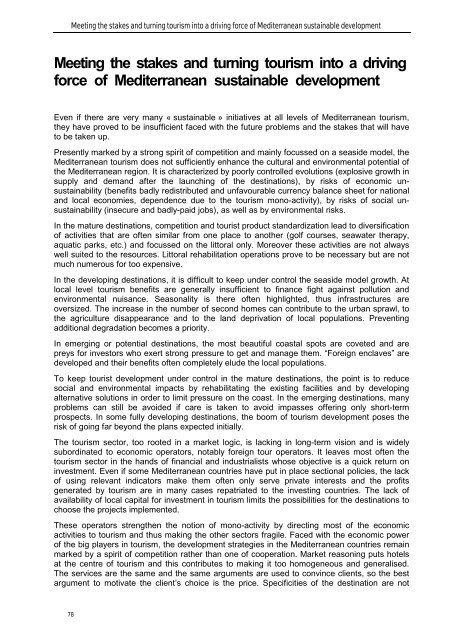dossier sur le tourisme et le développement durable
dossier sur le tourisme et le développement durable
dossier sur le tourisme et le développement durable
You also want an ePaper? Increase the reach of your titles
YUMPU automatically turns print PDFs into web optimized ePapers that Google loves.
Me<strong>et</strong>ing the stakes and turning tourism into a driving force of Mediterranean sustainab<strong>le</strong> development<br />
Me<strong>et</strong>ing the stakes and turning tourism into a driving<br />
force of Mediterranean sustainab<strong>le</strong> development<br />
Even if there are very many « sustainab<strong>le</strong> » initiatives at all <strong>le</strong>vels of Mediterranean tourism,<br />
they have proved to be insufficient faced with the future prob<strong>le</strong>ms and the stakes that will have<br />
to be taken up.<br />
Presently marked by a strong spirit of comp<strong>et</strong>ition and mainly focussed on a seaside model, the<br />
Mediterranean tourism does not sufficiently enhance the cultural and environmental potential of<br />
the Mediterranean region. It is characterized by poorly control<strong>le</strong>d evolutions (explosive growth in<br />
supply and demand after the launching of the destinations), by risks of economic unsustainability<br />
(benefits badly redistributed and unfavourab<strong>le</strong> currency balance she<strong>et</strong> for national<br />
and local economies, dependence due to the tourism mono-activity), by risks of social unsustainability<br />
(insecure and badly-paid jobs), as well as by environmental risks.<br />
In the mature destinations, comp<strong>et</strong>ition and tourist product standardization <strong>le</strong>ad to diversification<br />
of activities that are often similar from one place to another (golf courses, seawater therapy,<br />
aquatic parks, <strong>et</strong>c.) and focussed on the littoral only. Moreover these activities are not always<br />
well suited to the resources. Littoral rehabilitation operations prove to be necessary but are not<br />
much numerous for too expensive.<br />
In the developing destinations, it is difficult to keep under control the seaside model growth. At<br />
local <strong>le</strong>vel tourism benefits are generally insufficient to finance fight against pollution and<br />
environmental nuisance. Seasonality is there often highlighted, thus infrastructures are<br />
oversized. The increase in the number of second homes can contribute to the urban sprawl, to<br />
the agriculture disappearance and to the land deprivation of local populations. Preventing<br />
additional degradation becomes a priority.<br />
In emerging or potential destinations, the most beautiful coastal spots are cov<strong>et</strong>ed and are<br />
preys for investors who exert strong pres<strong>sur</strong>e to g<strong>et</strong> and manage them. “Foreign enclaves” are<br />
developed and their benefits often comp<strong>le</strong>tely elude the local populations.<br />
To keep tourist development under control in the mature destinations, the point is to reduce<br />
social and environmental impacts by rehabilitating the existing facilities and by developing<br />
alternative solutions in order to limit pres<strong>sur</strong>e on the coast. In the emerging destinations, many<br />
prob<strong>le</strong>ms can still be avoided if care is taken to avoid impasses offering only short-term<br />
prospects. In some fully developing destinations, the boom of tourism development poses the<br />
risk of going far beyond the plans expected initially.<br />
The tourism sector, too rooted in a mark<strong>et</strong> logic, is lacking in long-term vision and is widely<br />
subordinated to economic operators, notably foreign tour operators. It <strong>le</strong>aves most often the<br />
tourism sector in the hands of financial and industrialists whose objective is a quick r<strong>et</strong>urn on<br />
investment. Even if some Mediterranean countries have put in place sectional policies, the lack<br />
of using re<strong>le</strong>vant indicators make them often only serve private interests and the profits<br />
generated by tourism are in many cases repatriated to the investing countries. The lack of<br />
availability of local capital for investment in tourism limits the possibilities for the destinations to<br />
choose the projects imp<strong>le</strong>mented.<br />
These operators strengthen the notion of mono-activity by directing most of the economic<br />
activities to tourism and thus making the other sectors fragi<strong>le</strong>. Faced with the economic power<br />
of the big players in tourism, the development strategies in the Mediterranean countries remain<br />
marked by a spirit of comp<strong>et</strong>ition rather than one of cooperation. Mark<strong>et</strong> reasoning puts hotels<br />
at the centre of tourism and this contributes to making it too homogeneous and generalised.<br />
The services are the same and the same arguments are used to convince clients, so the best<br />
argument to motivate the client’s choice is the price. Specificities of the destination are not<br />
78
















